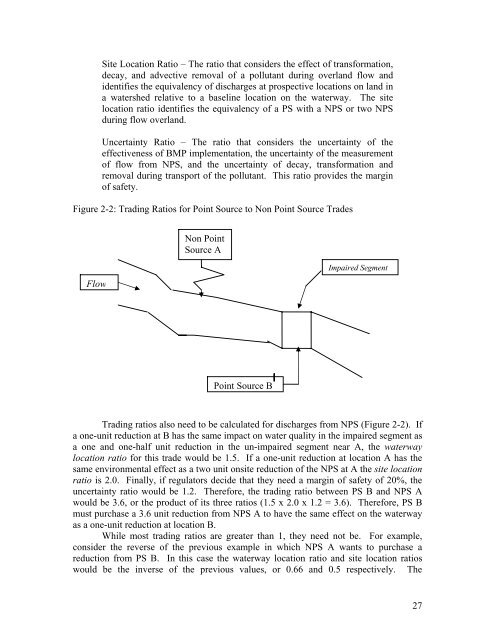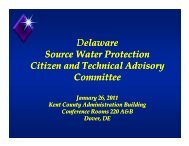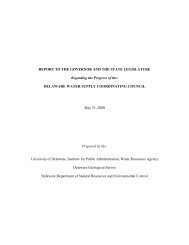Water Quality Trading in the Lower Delaware River Basin: A ...
Water Quality Trading in the Lower Delaware River Basin: A ...
Water Quality Trading in the Lower Delaware River Basin: A ...
Create successful ePaper yourself
Turn your PDF publications into a flip-book with our unique Google optimized e-Paper software.
Site Location Ratio – The ratio that considers <strong>the</strong> effect of transformation,<br />
decay, and advective removal of a pollutant dur<strong>in</strong>g overland flow and<br />
identifies <strong>the</strong> equivalency of discharges at prospective locations on land <strong>in</strong><br />
a watershed relative to a basel<strong>in</strong>e location on <strong>the</strong> waterway. The site<br />
location ratio identifies <strong>the</strong> equivalency of a PS with a NPS or two NPS<br />
dur<strong>in</strong>g flow overland.<br />
Uncerta<strong>in</strong>ty Ratio – The ratio that considers <strong>the</strong> uncerta<strong>in</strong>ty of <strong>the</strong><br />
effectiveness of BMP implementation, <strong>the</strong> uncerta<strong>in</strong>ty of <strong>the</strong> measurement<br />
of flow from NPS, and <strong>the</strong> uncerta<strong>in</strong>ty of decay, transformation and<br />
removal dur<strong>in</strong>g transport of <strong>the</strong> pollutant. This ratio provides <strong>the</strong> marg<strong>in</strong><br />
of safety.<br />
Figure 2-2: <strong>Trad<strong>in</strong>g</strong> Ratios for Po<strong>in</strong>t Source to Non Po<strong>in</strong>t Source Trades<br />
Flow<br />
Non Po<strong>in</strong>t<br />
Source A<br />
Po<strong>in</strong>t Source B<br />
Impaired Segment<br />
<strong>Trad<strong>in</strong>g</strong> ratios also need to be calculated for discharges from NPS (Figure 2-2). If<br />
a one-unit reduction at B has <strong>the</strong> same impact on water quality <strong>in</strong> <strong>the</strong> impaired segment as<br />
a one and one-half unit reduction <strong>in</strong> <strong>the</strong> un-impaired segment near A, <strong>the</strong> waterway<br />
location ratio for this trade would be 1.5. If a one-unit reduction at location A has <strong>the</strong><br />
same environmental effect as a two unit onsite reduction of <strong>the</strong> NPS at A <strong>the</strong> site location<br />
ratio is 2.0. F<strong>in</strong>ally, if regulators decide that <strong>the</strong>y need a marg<strong>in</strong> of safety of 20%, <strong>the</strong><br />
uncerta<strong>in</strong>ty ratio would be 1.2. Therefore, <strong>the</strong> trad<strong>in</strong>g ratio between PS B and NPS A<br />
would be 3.6, or <strong>the</strong> product of its three ratios (1.5 x 2.0 x 1.2 = 3.6). Therefore, PS B<br />
must purchase a 3.6 unit reduction from NPS A to have <strong>the</strong> same effect on <strong>the</strong> waterway<br />
as a one-unit reduction at location B.<br />
While most trad<strong>in</strong>g ratios are greater than 1, <strong>the</strong>y need not be. For example,<br />
consider <strong>the</strong> reverse of <strong>the</strong> previous example <strong>in</strong> which NPS A wants to purchase a<br />
reduction from PS B. In this case <strong>the</strong> waterway location ratio and site location ratios<br />
would be <strong>the</strong> <strong>in</strong>verse of <strong>the</strong> previous values, or 0.66 and 0.5 respectively. The<br />
27




